The moon changing its shape each night is a great mystery in children’s brain. So, let us construct different phases of the moon using the kid’s favourite cookies, Oreos.
This activity’s best part is that it is an edible cum science cum STEM activity that reveals different shapes of moon phases and their names.
Let’s explore the phases of moon using Oreo Cookies.
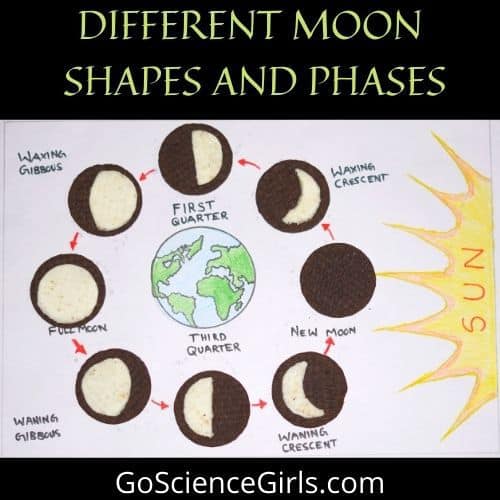
Supplies you need
Here is the list of items you need to gather on your experiment table to construct the moon’s model of different phases.
1) A pack of Oreo Cookies
2) Popsicle Sticks
3) Kid Friendly Knife (butter knife)
4) A ceramic or paper plate
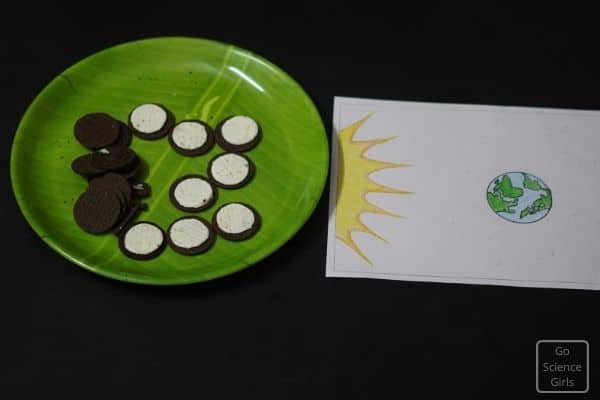
Instructions
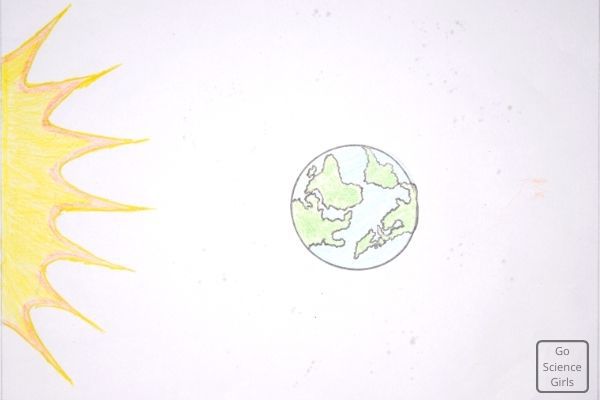
Step-1: Take 8 Oreos and separate the top and bottom biscuits slowly by twisting such that the inside frosting gets attached to the bottom side biscuit.
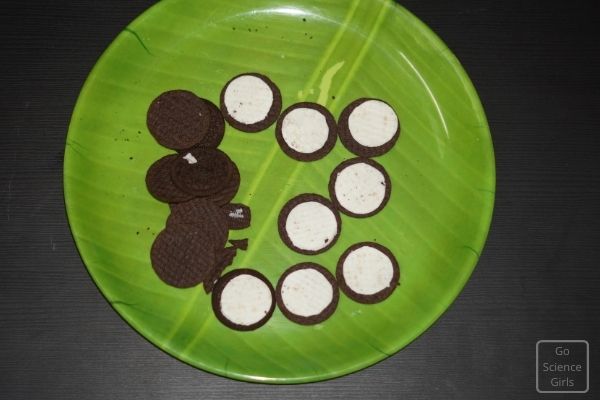
The other one is left without frosting, which we do not use in the experiment. So, keep it side or eat it.
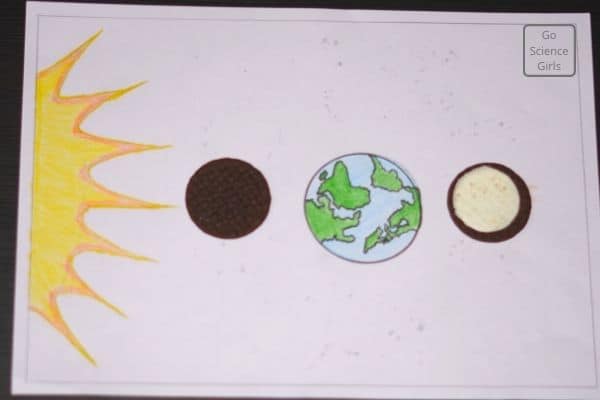
Step-2: Ask the child to chop off the frosting using a kid-friendly knife or Popsicle stick.
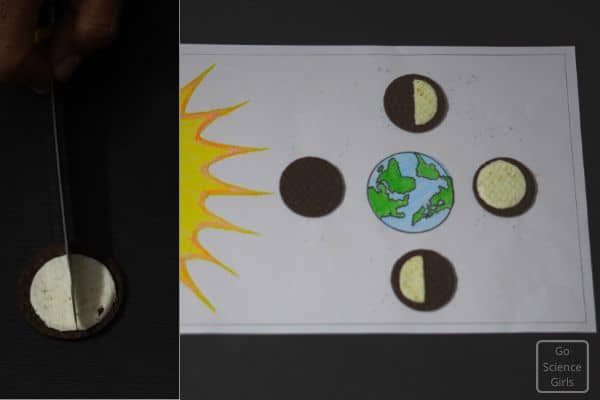
Give a print of different phases of moon to your child so that he/she can scrape off the frosting according to the various stages of moon shapes.
Step-3: Once your child finishes with scraping the frosting of Oreo, let him/her arrange the moon phases and shapes in the correct order.
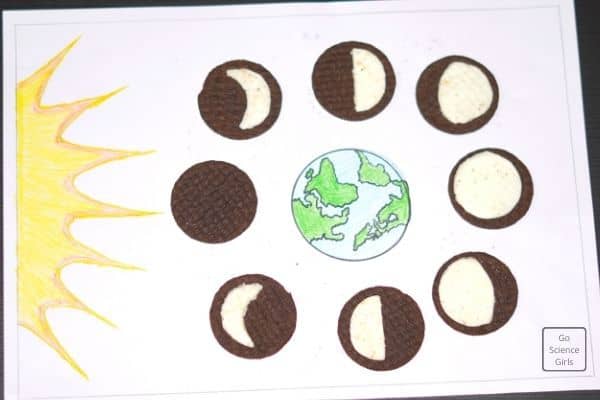
If you want, you can refer to the pictures attached in the post to create the correct Oreo Phases of Moon.
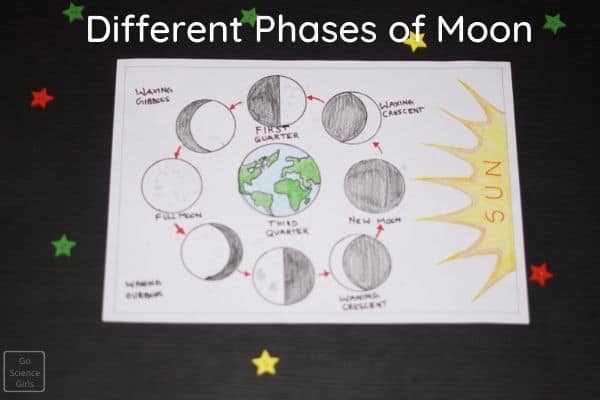
Note/Tip: You can help your younger kids by drawing fine lines over the frosting while making moon phase’s model with Oreos.
Older kids can easily scrape off the moon phases, either using their imagination and knowledge on the moon or seeing the reference pictures.
However, children need to concentrate on the shapes of frosting while scraping off. If they go wrong, they need to pick another fresh Oreo cookie to construct the desired shape. Adjusting the figures over and over using the same cookie is not advisable.
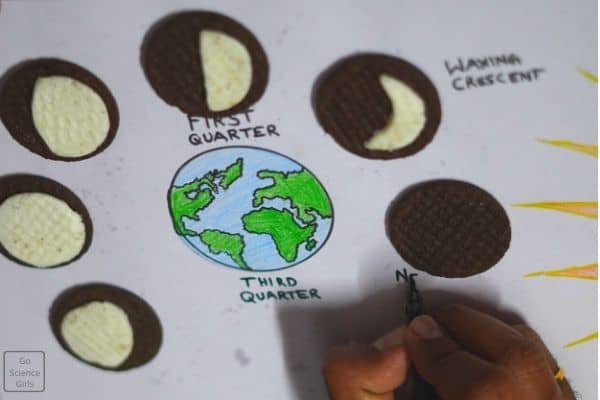
Step-4: Finally, arrange the Oreo models in the correct order according to their stages of changing moon shape.
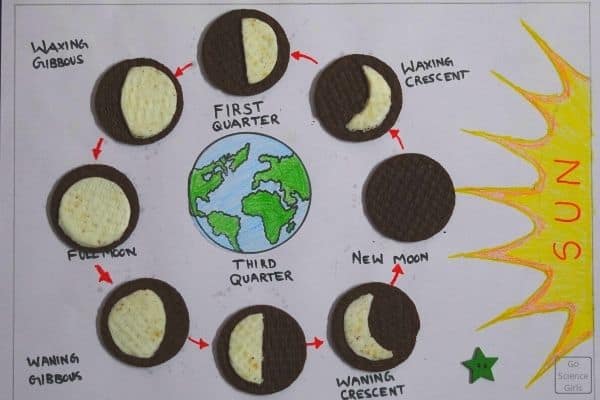
This model must represent how moon changes its shape from complete to half-moon every 28 days. So, construct every phase of moon in Oreo cookies. After the experiment, kids can munch on them.
The Different Moon Shapes and Phases
From Earth, the moon looks different in its shape every night. Some nights, it appears as a narrow crescent and some nights, it seems like a bright full moon. The changes in the shape of moon when we look up in the sky every night is what we call ‘Phases of the Moon’.
What is the cause of the different shapes of the Moon?
Moon does not have any light, but what is the light we see and feel every night from the moon?
That is the reflection of sunlight falling on the moon. When the moon rotates around the Earth, the moon faces the Sun either in its half side or entire side or quarter part.
At this point in the stage, the sunlight reflects on the moon and appears as the moon emitting light. That is when we observe different phases of the moon from Earth.
Every 29.5 days, we see the change in the shape of the moon and a different phase.
As the moon’s angle changes every day from the Earth, it appears in a new form every day. And Sun plays a significant role in allowing us to watch things around us and up in the sky.
Moon and stars do not emit any light on their own astronomically.
Eight Phases of Moon
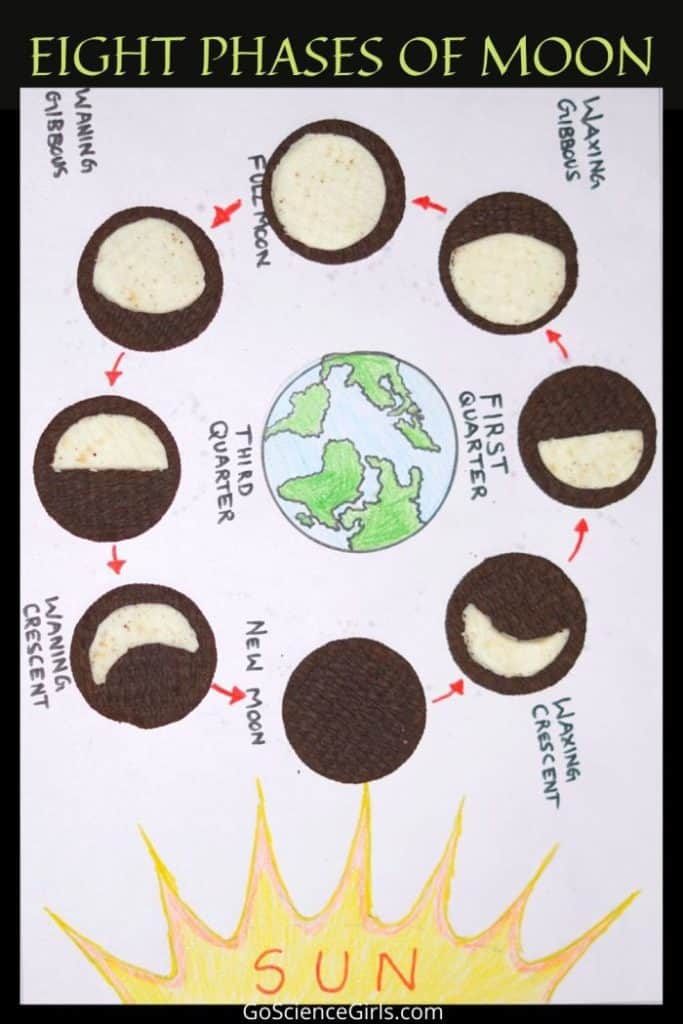
The eight major and different phases of moon include:
1) New Moon
2) Waxing Crescent
3) First Quarter
4) Waxing Gibbous
5) Full Moon
6) Waning Gibbous
7) Third Quarter
8) Waning Crescent
Let us learn all the eight phases of moon in detail!!
New Moon
The new moon is the first phase that is not visible to our eyes from the Earth. It is not visible because the moon comes in between Earth and Sun while rotating around the Earth.
And the face of moon facing us receives no or dull sunlight, so we cannot see the full moon.
When the Moon, Sun and Earth come in correct alignment, Sun’s complete eclipse happens. Also, during the new moon phase, we can see the total solar eclipse.
The waxing Crescent
The waxing Crescent is the second phase where moon grows!
Growing in a sense, a small slice of moon is visible due to the reflection of sunlight on it. At this stage, we say moon is in the waxing crescent phase.
Actually, during the olden days, the moon is waxing crescent stage is known as the new moon phase, while the new moon phase is known as Dark Moon.
Surprisingly, the traditional culture of calling the waxing crescent phase the new moon is still in use, e.g. Islamic Calendar.
However, we see a tiny slice of the moon and the rest of it from Earth because Earth also throws some light on the moon, making it visible to some extent.
The First Quarter Moon
The third phase of different phases of moon is known as the first quarter moon or half-moon.
In this stage, we see moon in half of its size and lies at a right angle to the Earth and Sun alignment. The other half remains dark as there is no sunlight falling on it.
This phase happens precisely after a week to the new moon phase. The name ‘quarter’ refers to ‘extent of orbit that the moon revolved and covered since its beginning phase, New Moon.
The Waxing Gibbous
The immediate phase after the first quarter is known as Waxing Gibbous.
In this phase, we see moon more than half of its size from Earth, and gradually the shape (waxes) of the moon also increases day by day.
The word gibbous originated from the Latin word, ‘Gibbus,’ which means hunched or raised. This phase happens between the full moon and the first quarter phase.
The Full Moon
The full moon is an eye treat to us from Earth’s view because, in this phase, we see moon in its full size. That means the moon seems completely bright as the reflection of sunlight lights it up.
The full Moon phase happens when the moon lies on Earth’s opposite side where sunlight does not fall.
It means that the Earth stays in between Moon and the Sun while moon rotating around the Earth’s orbit. Also, during the full moon phase, we see a total eclipse of moon.
The waning gibbous
Waning means fading off sunlight reflection from the moon. Waning is an English term from the past, ‘Wonian’, which means decreasing or shrinking.
To simply put, during this phase, moon loses its maximum brightness and appears less in its size.
It almost looks like waxing gibbous where the moon appears more than half of the size, but the moon’s brighter side diminishes gradually.
Due to a decrease in the sunlight fraction reflected on the moon, it happens between the full moon and half-moon.
The Last Quarter
The last quarter moon is also known as a half-moon. In this phase, moon appears as half of its portion illuminated by the reflection of sunlight.
But this time, it happens on the opposite side of the first quarter moon. From Earth we see half of the moon that is reflected with sunlight.
The Waning Crescent
The Waning Crescent is the final stage of moon phases, and it is visible when the crescent moon is visible.
During this moon phase, the sunlight fraction slowly decreases to less than half-moon, and it appears only a small portion of the moon is lit up. And from the Earth, this lit portion is visible as a beautiful ‘U’ shape crescent.
Sometimes, because of the Earth’s light reflecting on the rest of the moon towards the end, the moon appears completely.
Each month we see this whole cycle of different phases of moon from Earth, one after the other, clearly and beautifully.
Moon takes 29.5 days to complete a round around the Earth, which means it takes 29.5 days to complete its cycle of 8 different phases.
Apart from these 8 different moon phases, there are some more critical terms regarding moon we need to explore, which include:
Blue Moon: Blue Moon is a rare phase of the moon that appears only once in 3 years. If you remember, we say once in a blue moon, which is our common phrase used in everyday language.
It refers to things that hardly ever happen, which matches the meaning of the blue moon as it appears every 3 years.
We can see a blue moon only when the sky is clear with free of pollution. Watching a blue moon is an excellent view to viewers from Earth as it resembles the full moon.
That means the moon appears with maximum brightness. Usually, the second full moon in the calendar is mentioned as Blue Moon.
Super-Pink Moon: Super-Pink Moonis also known as Super Moon, and it appears when the moon’s orbit comes closest to the Earth’s orbit.
We can witness the super moon every year between March and May months. In 2020, people noticed the super moon on April 7th and 8th, which is the largest and best year.
In this phase, moon appears 7% bigger and 15% livelier than a usual full moon.
And by tradition, the full moon of April month is referred to as the pink moon every year because of the blooming of a wild pink flower, Ground Phlox.
Super Pink Moon is also known as Egg Moon, Sprouting Grass Moon, and Fish Moon.
Eclipses generally happen when the position of the Sun, Moon and Earth aligned in particular orbits. Let us learn about two critical eclipses that we often come across.
Solar Eclipse: During the rotation of moon around the Earth’s orbit, sometimes it comes between the Earth and Sun, blocking the reflection of sunlight on the Earth.
That is the reason some parts of the Earth experiences shade and no sunlight. Eventually, this causes the eclipse of the Sun, which is known as solar eclipse.
During a solar eclipse, the moon stays closer to the ecliptic plane.
Lunar Eclipse: Lunar eclipse is the phase where Earth blocks the sunlight falling on the moon. It happens only during the Full Moon.
During a lunar eclipse, there occurs a close alignment of the Sun, Earth, and Moon. A lunar eclipse happens in three types, i.e. complete, half-done, and penumbral.
Cookie Moon Phases Work Sheets
Worksheets are the best way to keep children aware of what is happening during their lab activities. We provide you with the best worksheets in a wide range that suits children of all ages.
These worksheets are handy for students to understand different phases of moon in a fun and educational way. Browse our worksheets and encourage students to do various lab activities with joy.
Cookie Moon Phases Lesson Plan
Student Name—————-
Batch Number—————-
Moon, when rotating around the Earth in its orbit, goes through 8 different phases. Eight phases of the moon happen based on the amount of sunlight falling on the moon and the Earth’s view.
Students get to learn about different stages of the moon through the Oreo Cookie Moon Phases Science Experiment. Here is what students need to concentrate on while learning about moon phases.
1. _______________________________ New Moon (Completely Dark)
2. _______________________________ Waxing Crescent (small portion of moon illuminates)
3. _______________________________ First Quarter (Right half of moon illuminates)
4. _______________________________ Waxing Gibbous (small portion is left dark on left side)
5. _______________________________ Full Moon (the full moon completely illuminates)
6. _______________________________ Waning Gibbous (right side brightness diminishing starts)
7. _______________________________ Last Quarter (left side of moon illuminates)
8. _______________________________ Waning Crescent (small left part of moon is lit up)
Education Objectives
Students learn the below objectives once they finish constructing the ‘Different Phases of Moon’ model in this activity.
- Able to explain about different phases of moon
- They can experience and explore how moon changes its shape every night when looked at from Earth
- Learn about the moon changing conditions throughout the month
- Learn about how moon rotates around the Earth and how sunlight affects the light of the moon
- Explore the science behind the moon phases and the cycle that happens every four weeks.
Assessments & Calculation & Analysis
Teachers can ask students to draw or build moon phases using their talent and other materials.
Then, evaluate their models and drawings on moon phases based on accuracy, proper labelling, and correct phases.
Students who are still confused to draw moon phases provide them with pre-labelled paper strips and drawings. And ask them to match the proper picture to the correct label.
Cookie Moon Phases Lab Activities
Discussion on Moon Shape
Q.1: What is the best time to see the moon?
A: Night is the best time to see moon as it reflects a light emitting from the Sun and appears lovely.
It doesn’t mean that we cannot see moon during daylight.
Of course, we can see the moon during the daytime but only on particular days and time.
Q.2: How moon changes its shape every night?
A: Moon does not have its light! The light-emitting from moon is the light of the Sun reflecting while moon rotating around the Earth.
Based on the Sun, Earth and Moon alignment, the moon shows different phases and changes in its shape every night.
Sometimes, we see moon in silver white and sometimes as a whole moon because of the amount of sunlight falling on moon.
Q.3: How to create a Moon phases chart?
A: Creating a moon phase’s chart is the best way to relate moon phases in real-life.
Make a colourful chart with eight boxes, labelling each box as each phase. Ask the students to look at the moon and draw their observation in Box-1.
Wait for 3-4 days and again ask them to watch the moon and draw in box-2.
Please direct them to continue the same until they fill eight boxes. It is the best way for students to observe different moon phases in reality.
FAQs
It takes 8 Oreos to make eight different phases of the moon. Because the moon passes through eight different shapes when rotating around the Earth.
And it happens through a cycle, which takes 29 days to complete one cycle of moon phases.
The difference in the moon’s shape is not real but apparent!
Yes, the moon never changes its actual shape, but it seems to be changing conditions because of the sunlight reflecting on it while rotating around the Earth.
During a 29 day cycle of rotation around Earth, the moon experiences low to complete illumination due to sunlight.
Hence, the apparent change in the moon’s shape from Earth is due to the moon, sun, and Earth’s alignment.
And when we see from Earth, the shape of the moon changes every night based on the amount of sunlight reflecting on it.
The moon doesn’t cast a shadow on Earth due to its tilted orbit around the Earth.
Yes, because of the tilted rotating orbit around the Earth, the moon does not cast a shadow and still faces enough sunlight from the Sun even it comes behind the Earth.
Besides, the Earth’s orbit around the Sun plays a vital role in casting Earth’s shadow on the moon.
Absolutely, yes! We can see the moon during daylight but only sometimes. And the reason behind this is the same as we can see the moon at night. I.e. the sunlight reflecting on the moon helps us see the moon partial or complete from the Earth.
If we witness the moon during the day, it is experiencing enough sunlight from the Sun and appearing bright.
There are eight phases of the moon during which the moon experiences partial illumination due to the sunlight.
Based on the waxing and waning of moon phases, the names are given to the moon phases.
There is an excellent relationship between the phases of the moon and the months of the year.
According to the moon phases cycle, every month, we can see one full moon on average. And there are 12 names to these moon phases happening every month. Here are the terms of 12 moon phases of 12 months.
1) Wolf Moon
2) Snow Moon
3) Worm Moon
4) Pink Moon
5) Flower Moon
6) Strawberry Moon
7) Buck Moon
8) Sturgeon Moon
9) Full Corn Moon
10) Hunter’s Moon
11) Beaver Moon
12) Cold Moon
13) The Blue Moon
